Hazards Caused By El Niņo
Climate
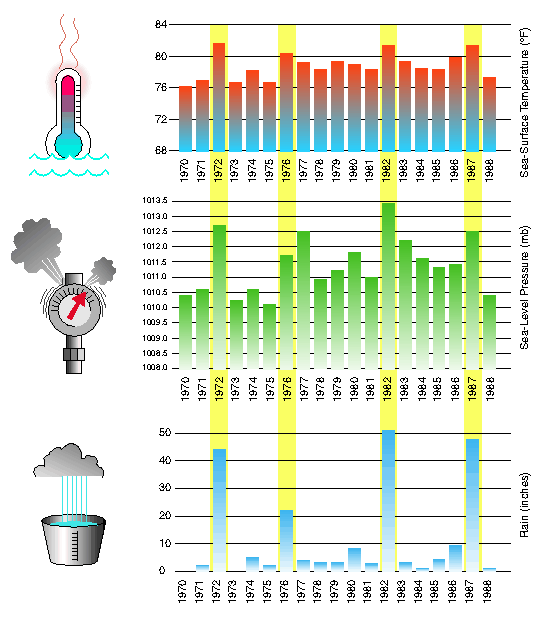 |
The yellow shading represents years in which an El Niņo event had
occurred, and their results of sea-surface temperature along the
equator in the eastern Pacific, in barometer readings at Darwin, and
in rainfall measurements at Christmas Island in the central Pacific
are outstanding.
http://www.atmos.washington.edu/gcg/RTN/Figures/RTN10.html
|
[top]
Floods and Droughts
The 1982-83 El Niņo caused the upper-level ridge off the West coast of
the United States to be stronger, inducing an increase of amplitude of the
waves as shown below. This event had led a warming in the Pacific regions of
North America, and as a result produced heavier rains in the south (during
that period), causing a wide spread flooding.
| Normal Winter |
El Niņo Winter |
|
|
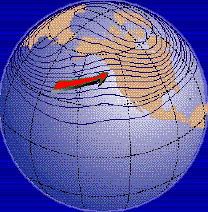 |
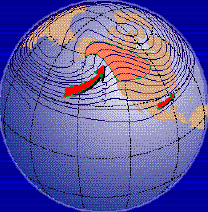 |
|
Images were taken
from DAS, University of Washington without permission
| THE 1982-83 EL
NIŅO
FLOOD |
|
|
|
The map
shows the distribution of temperatures during this particular El Niņo
(red-warm, blue-cool).
The storms
produced by this El Niņo had caused over $100 million of damage in
California. About $25 million of the damage occurred in Orange County,
where big waves and heavy rain damaged piers, triggered mudslides and
flooded residential areas and freeways. |
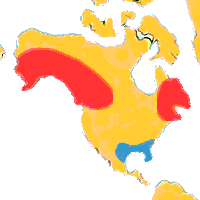 |
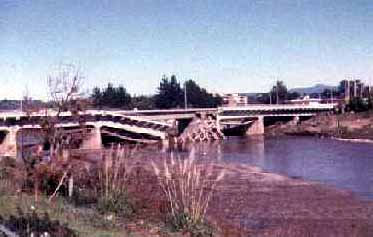
http://www.santacruzpl.org/history/disaster/scflood1.shtml |
|
THE 1982-83 EL
NIŅO
DROUGHT |
|
|
During this event, it was seen that in North America,
the Pacific Northwest in the U.S., western Canada and parts of Alaska
showed warmer temperatures in 81% of the years while the south-eastern
U.S. showed below normal temperatures around 80% of the time.
During the summer, heat waves and below-normal
precipitation brought about severe drought, crop failures, and even
death. |
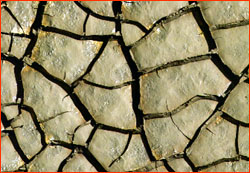 |
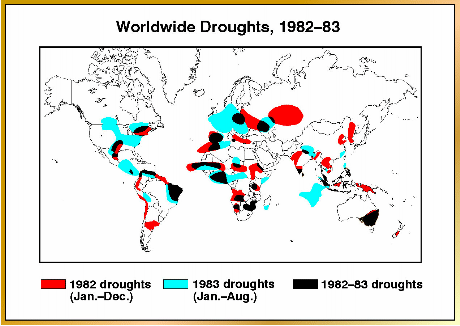
http://enso.unl.edu/ndmc/enigma/elnino.htm |
[top]
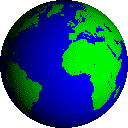
It was announced at the Spring American Geophysical Union annual
convention in Boston 27-19 May, 1998, John Gipson at NVI Inc based at the NASA, Goddard Space Flight Center that El Nino had increased the length of the day by
600-700 microseconds. Air currents change their location on the earth, and
their distance from the earth's centre by a few miles. The atmosphere
carries air in clouds, and hence the earth's rotation is constantly
changing due to the conservation of angular momentum.
[top]
El Niņo is a global phenomenon.
It is extremely important to gain a better understanding of them as they can
only be predicted. It had caused a lot of damages all over the world over
the last decade.
-
Collapse of fisheries off
Peruvian communities
-
Regions of Pacific basin which
are usually wet experience drought
-
Regions of Pacific basin which
are usually dry experience torrential rain
-
Cyclones are more frequent,
occurring eastward of their normal limit. (1982-83 French Polynesia struck
by 5 cyclones. they usually do not experience cyclones)
-
Extremely cold winters in North
America and Eurasia
-
Droughts to communities in
Brazil
-
Water shortages in Ethiopia
-this country is extremely vulnerable to drought and famine.
-
Heavy rain causing severe mud
slides off the coast of Southern California.
It is said that the world is experiencing higher temperatures than ever before.
However, people continue to cut down trees and polluting the earth even
more. Trees are essential sources to the earth, absorb toxins but up to a
certain point, then the toxins will eventually kill the tree. They take in CO2 and produce O2 some of which we humans and other
living things use, some also goes up into the atmosphere and is converted
into O3 (ozone), keeping the ozone layer strong. Less
trees more CO2, less O2, less O3, more CO2 (green house effect).
Therefore, let us save the trees on this earth, to keep it a healthy place
to live.
[top]







